Microsoft Surface 2 Review
by Anand Lal Shimpi on October 21, 2013 12:00 AM ESTSoC, CPU & Performance
At the heart of Microsoft’s Surface 2 is a quad-core NVIDIA Tegra 4 SoC. That’s four usable ARM Cortex A15 cores running at up to 1.7GHz (1.9GHz with only a single core active), behind a shared 2MB L2 cache. You also get NVIDIA’s most powerful ultra mobile GPU to-date, a 72-core implementation of its ultra low power GeForce architecture. The combination of the two gives Microsoft a much better platform than the original Surface RT device.
The difference is immediately apparent. While Surface RT felt slow, Surface 2 feels fast enough for most light workloads. Typing in Word now typically consumes < 20% of all available cores/CPU cycles, compared to 20 – 40% on last year’s Tegra 3 based model. I can still get CPU utilization as high as 50% by pounding on as many keys as fast as possible, but that’s the exception not the rule.
If you remember back to my first Surface RT review I talked about how I could sometimes type quicker than the system would be able to process and display my text. I’m happy to say that’s no longer an issue, although I’m not sure how much of it is software vs. hardware improvements. Needless to say that for general Office work, Surface 2 is a much better device than its predecessor.
Application launch times are also a bit better compared to Surface RT at launch. Some apps still take longer to initialize than their equivalents under Android or iOS, but the improvements over the past year have been significant. Applications that used to take 5 – 7 seconds to launch now take 2 – 4 seconds. That’s compared to the < 2 seconds for most of the core apps on iOS, but it’s movement in the right direction at least.
On the CPU side we don’t have a ton of great performance tests to let us compare platforms (not yet at least), but we do have our standard suite of js benchmarks. Since we’re dealing with Windows RT, the only browser option is Internet Explorer 11 – which is both a blessing and a curse depending on what benchmark you’re looking at.
I’ll start with SunSpider since that appears to be the best case for IE11. Here we see just how much software can influence the overall performance of these browser based benchmarks.
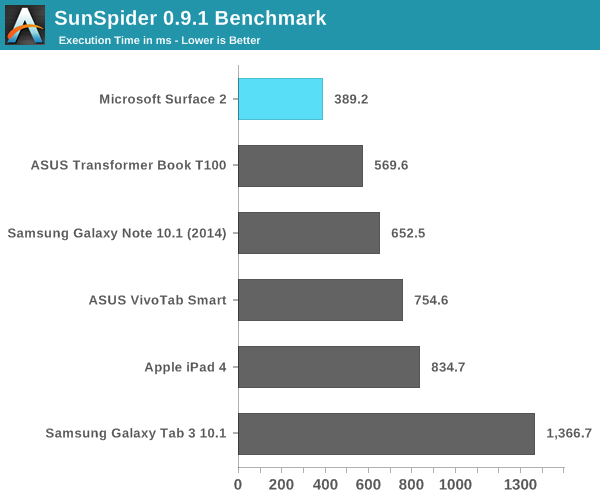
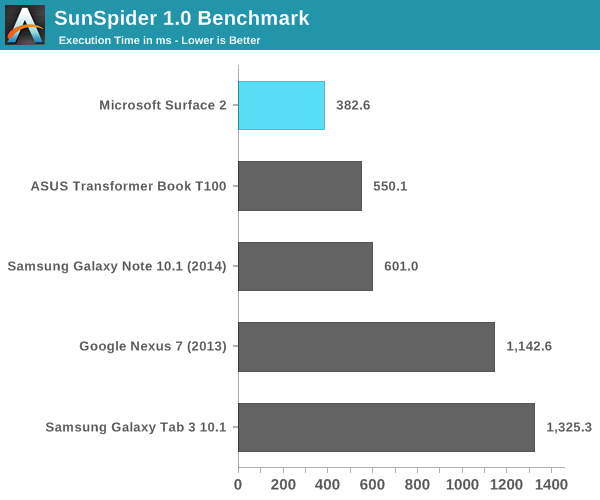
Tegra 4 running IE11 posts a better SunSpider score than even the A7 based iPhone 5s. Looking at the rest of the tests it’s very clear that SunSpider was an optimization target for Microsoft, as we don’t see this sort of performance leadership repeated anywhere else.
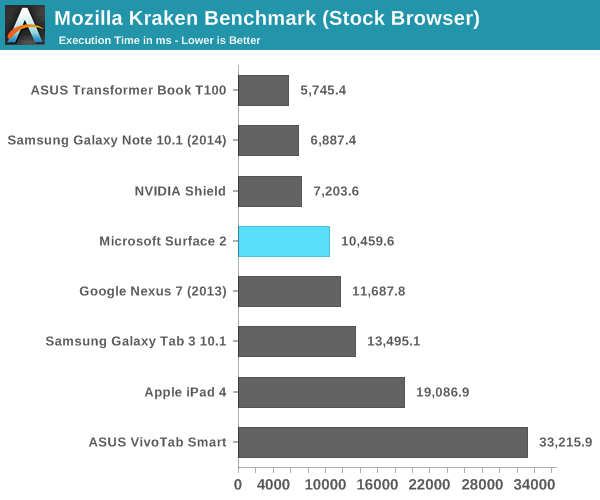
The Kraken results look decent but clearly behind high-end Android devices running Chrome. This is a huge improvement over where Microsoft was last year with Surface RT. Surface 2 can now complete the Kraken test in roughly 1/5 of the time it took Surface 1/RT to do the same work at launch. Obviously we’re seeing the benefits of IE11 in addition to Windows RT 8.1 being better optimized for ARM architectures (as well as a faster SoC), but the new tablet is just significantly faster than its predecessor.

Browsermark 2.0 gives us a good idea of where Surface 2 falls in terms of overall browsing performance. In general we’re dealing with a platform that is roughly comparable in performance to modern Android devices, but it’s not pushing the limits of performance in any way.

Google’s Octane test is obviously best optimized for Chrome, and here we see solid performance although clearly behind the fastest Android and Bay Trail devices.
GPU Performance
All of the Windows RT devices that launched last year had pretty terrible GPU performance. It didn’t matter if you had something with NVIDIA or Qualcomm inside, GPU performance wasn’t great at all. Even Intel’s competing Clover Trail solution was a huge let down on the GPU front. Clover Trail was so bad that I even noticed differences in animation frame rate between the Atom Z2560 and Qualcomm’s APQ8060A running Windows RT.
Tegra 4’s GPU on the other hand seems well suited for the task at hand. I doubt many users will be playing 3D games on Surface 2, but GPU performance is improved substantially over its predecessor. In the grand scheme of things we’re talking about roughly iPad 4 class GPU performance, all while driving a lower resolution screen.
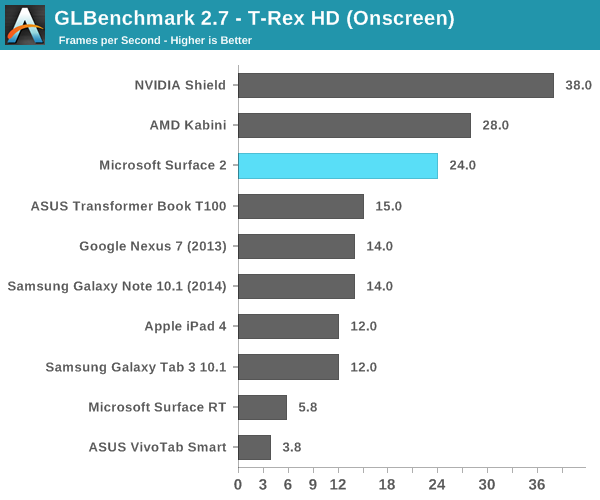
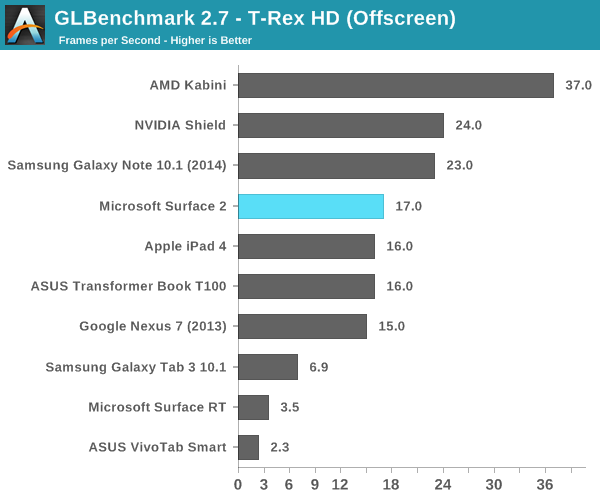
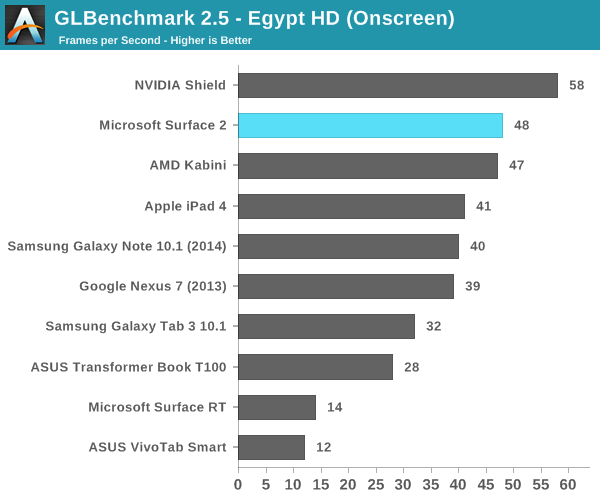
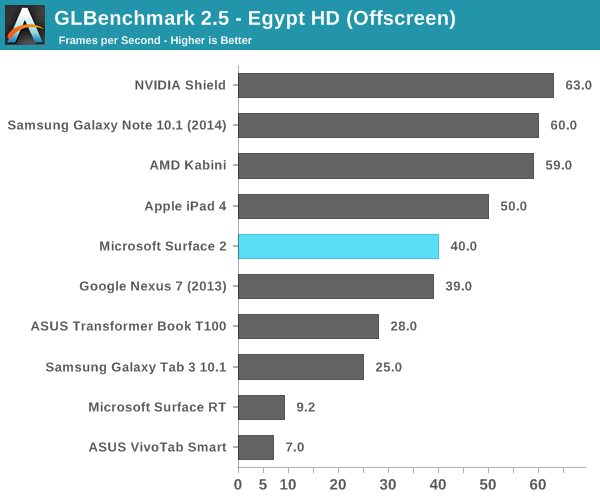



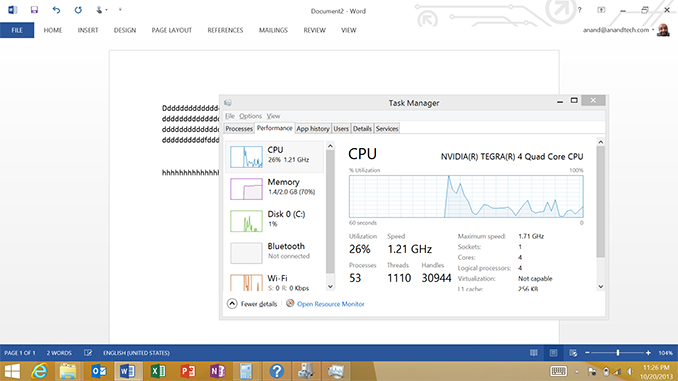








139 Comments
View All Comments
ancientarcher - Monday, October 21, 2013 - link
This is a great improvement over the original Surface. The huge increase on the GPU front obviously made it possible for MS to offer the higher resolution screen and along with a better CPU made it a lot smoother to use.The king of tablets - yes. But then, no one talks about how ios is incompatible with OSX! It's only with MS that people expect 100/100 every time. Only if Windows RT had been compatible with the Windows Phone ecosystem. Then there would not be so much noise about the app ecosystem.
I am beginning to think how good a device this will be in a year or so, particularly if MS manages to merge the Windows Phone ecosystem with this (after all both run on ARM so should be theoretically possible). And yes, slightly lighter with better battery life needed. With a few more apps, this will be the perfect device.
kyuu - Monday, October 21, 2013 - link
Hmm, let's see:iPad 4 - 9.51" H, 7.31" W, .37" D
Surface 2 - 10.81" H, 6.79" W, .35" D
Surface 2 is thinner. It's longer but less wide due to the larger screen and 16:9 aspect ratio, which is better for pretty much everything except using it as an ereader. I don't see how it's "big and unwieldly" yet the iPad is magical. And then...
iPad 4 - 1.44 lbs.
Surafce 2 - 1.45 lbs.
I guess that extra .01 lbs. is all you need to make the difference between magical and heavy? Also I suppose you missed the part where Anand noted that, due to the weight distribution, the Surface 2 actually feels lighter in-hand.
Add in the fit & finish, the kickstand, and the facts that you have an actual honest-to-god USB port (3.0 no less!), a mini-HDMI out, and a much more fully featured OS with WinRT 8.1 than iOS will ever be, and I really can't see how the Surface 2 loses a value or specs comparison unless you're married to the iOS ecosystem.
cheshirster - Monday, October 21, 2013 - link
Another half-assed review of MS product.What about multitasking, storage options, external displays, browser capabilities (flash for example, on-site video playback), speakers, skyping comparison?
Why are those google services are so special so that one must care about them?
Steinegal - Monday, October 21, 2013 - link
Agree, you can still access Google services in your browser if you need it. You also get so many possibilities to connect any device you want through the USB port, like printers, scanners, mouse, keyboard, game controllers cameras etc. You also have a powerful multiuser environment something every android tablet that has a half assed implementation of gets a big plus for. For me it's the multitasking that seals the deal, my iPad is mostly used for Facebook, browsing and YouTube/Netflix, and the surface can do all of those at the same time. No more swapping app to reply to a message in Facebook, no more stopping the video to do a quick search for information. I might miss out on a few great apps, but mostly it's just games and I'm quite tired of all those pay2win games that seems to populate the appstores now.Gigaplex - Monday, October 21, 2013 - link
Multitasking? The software doesn't really do a good job of supporting that.Daniel Egger - Monday, October 21, 2013 - link
I have to disagree. While I don't give a rats ass about multitasking in a tablet (or phone) because the screen only allows modal operation anyway it works reasonably well even on the old RT. Almost too well because you'll only notice two Flash videos playing at the same time when the audio clashes.kyuu - Monday, October 21, 2013 - link
I have to agree. There's too much focusing on comparing it 1-to-1 to an iPad or Google tab and Anand seems to miss or gloss over a lot of the the functionality.1) Mentions the multitasking only in passing.
2) No mention of connecting accessories through the USB port, including external storage.
3) No mention of external display support, where you can actually EXTEND the display rather than simply mirroring it.
4) No mention of how the browser handles flash or works to bring up websites for Twitter or all those Google services that he complains are missing in the app store.
5) Not Surface 2 specific, but the quality of the speakers should be noted.
cheshirster - Monday, October 21, 2013 - link
What are the strong points of bringing in Bay Trail and "full" windows? Why we should even care? What exactly that "full" means in 10.6 inch tablet ?Qwertilot - Monday, October 21, 2013 - link
Its a good question actually :) Even if MS did put an atom into these, they may well backport RT rather than full 8.1.They rather badly need to drive the touch based eco system before these devices can make proper sense.
Gigaplex - Monday, October 21, 2013 - link
3rd party desktop applications, so you can actually use the device while you wait for useful Store apps to become available.